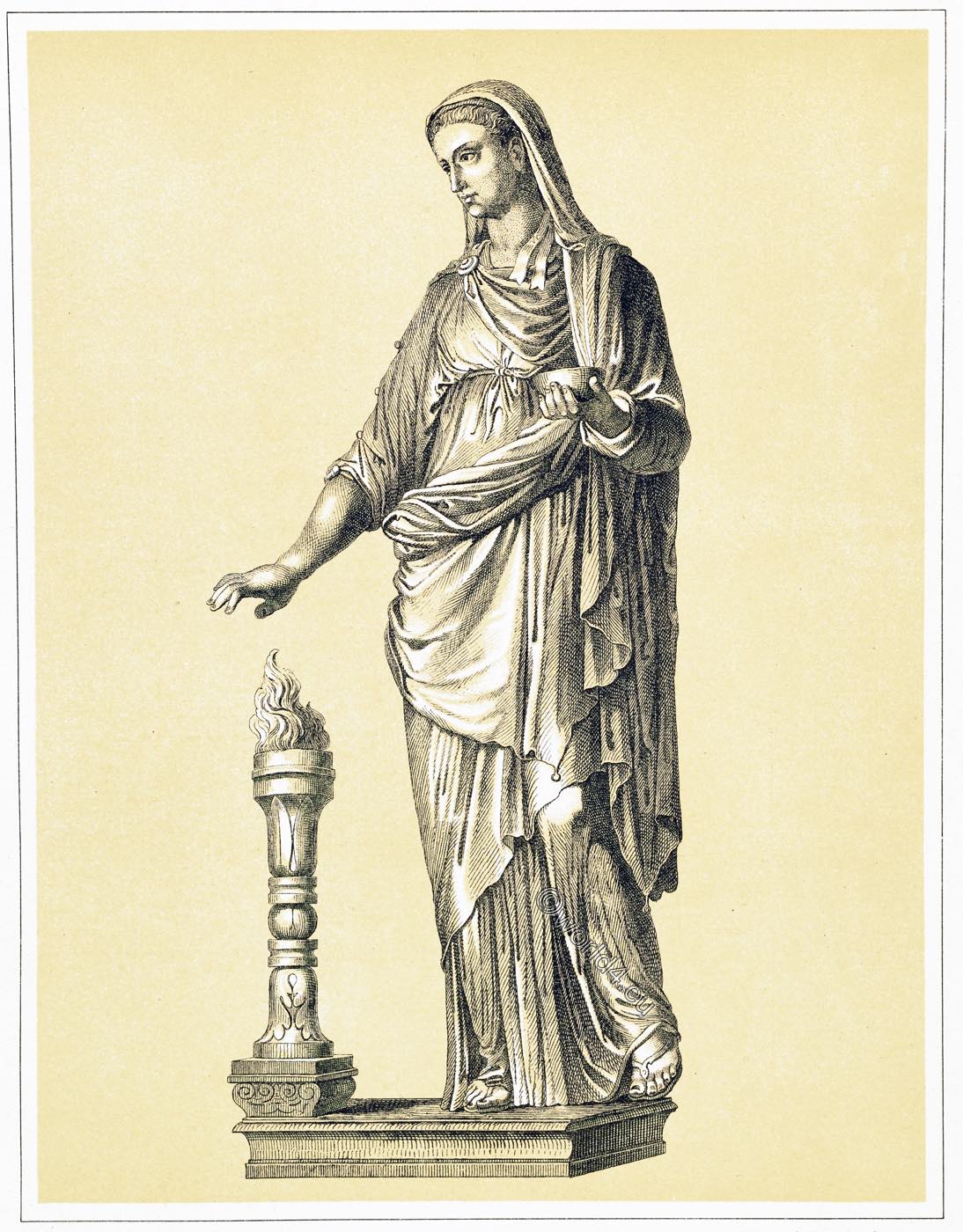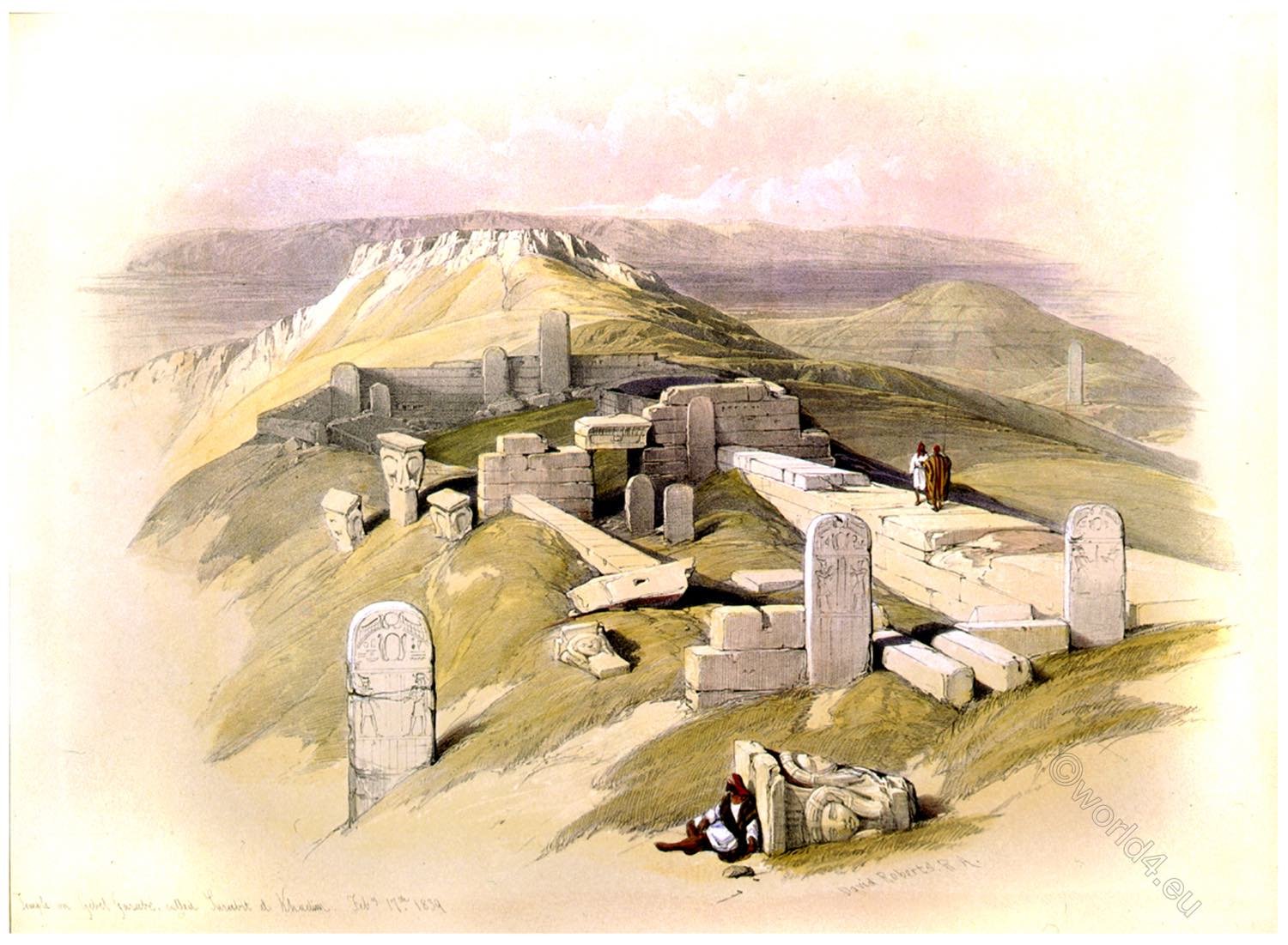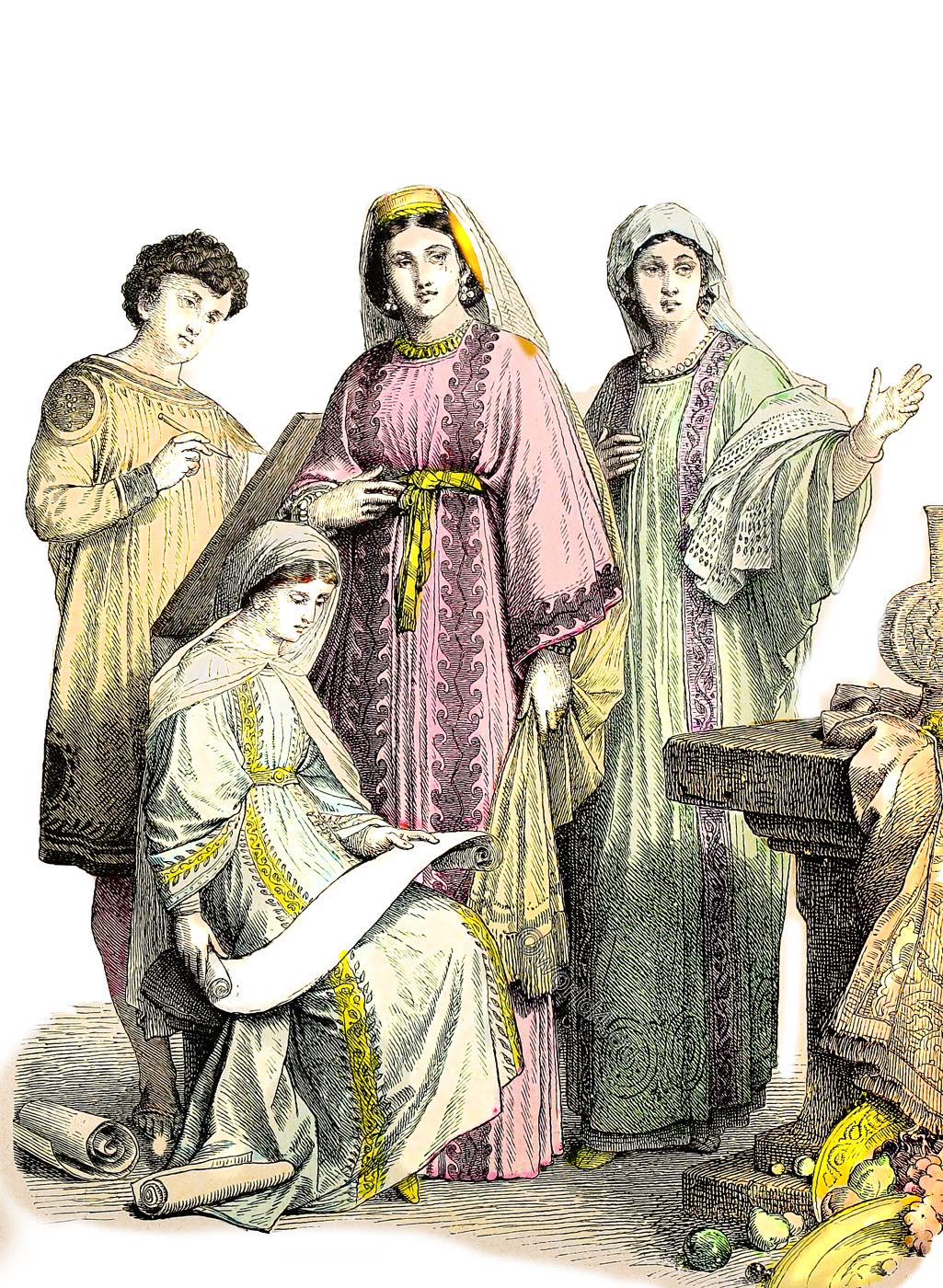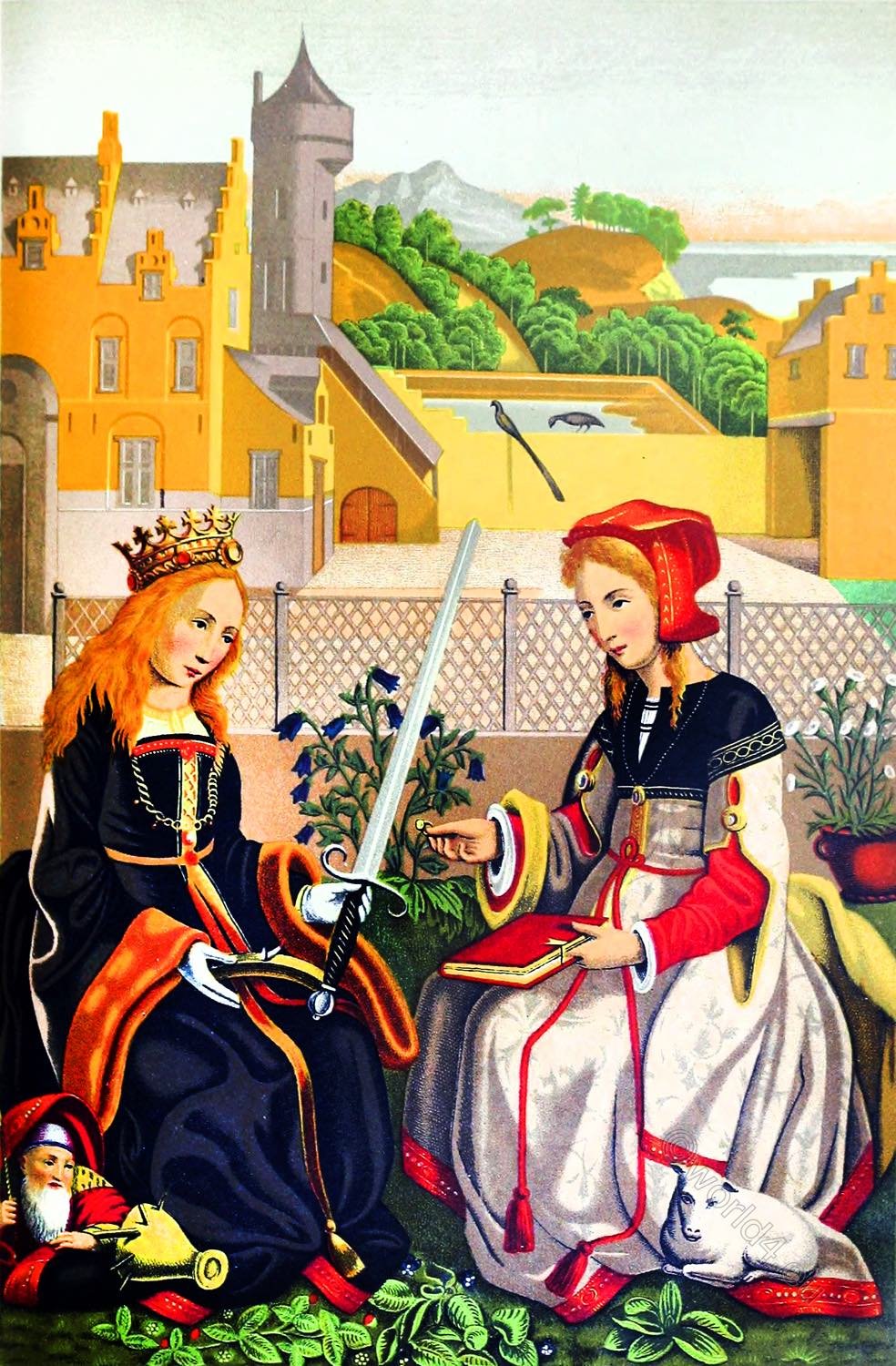
The clothing of the vestal virgins.
One of the oldest cults in Italy is the cult of Vesta. According to one myth, it came from Troy, from where it is said to have been brought by Aeneas, according to others it is of ancient Italian origin, as it can be found in Lavinium, Alba longa, Tibur and in the land of the Sabines. He was introduced to Rome by Numa, who appointed four virgins – the first were Gegania, Verenia, Canuleja, Tarpeja – to serve the goddess.
The number of vestal virgins was increased to six either by Tarquinius Priscus or by Servius Tullius. If a vacancy was left by death or resignation, twenty virgins were chosen by the pontiff M., from which “in concione” one was chosen by lot to fill the vacancy.
Every Roman virgin who had the necessary requirements was obliged to accept the position of a vestal virgin; only those who already had a sister among the vestal virgins, or the daughter of a Flemish, Augur, Quindeeimvir *), Septemvir or Salier, or the bride of a Pontiff or Tubicen sacrorum could refuse the choice. The virgin chosen had to be patrima and matrima, i.e. both freeborn parents had to be alive, she could not have any physical defect in herself and she could not be under six or over ten years old when she entered the priesthood.
*) The Quindecimviri sacris faciundis (literally: “Fifteen men to perform sacrifices”) were one of the four highest Roman colleges of priests. In ancient Rome, the quindecimviri sacris faciundis were the fifteen (quindecim) members of a college (collegium) with priestly duties. In particular, they guarded the Sibylline Books, writings which they consulted and interpreted at the request of the Senate. This collegium also supervised the worship of all foreign gods introduced in Rome.
After passing the entrance examination, the virgin’s hair was cut off and hung on an ancient lotus tree standing in the grove of Vesta, and then she was consecrated for thirty years of service to the goddess. In the first ten years the Vestal Sisters lived as novices and had to learn the ministry, in the second decennium they practiced it, and in the third they taught it to the newly elected novices. At the end of their term of service they could leave and marry, but this was considered questionable because it was believed that they did not bring happiness to the home, and most remained in service until their death. The oldest vestal virgin was considered prima inter pares, the most respected and had the supreme authority of the sacra.
The vestal virgins enjoyed a lot of privileges. When going out, they were accompanied by a Lictor, which even the consul avoided; on certain days they were allowed to ride in a two-wheeled state carriage, and the death penalty was imposed on insulting their person; their escort protected them from any attack and if they happened to meet a convicted criminal, he escaped punishment. Wills, contracts and treasures were believed to be kept most safely in their sanctuary. They had a special place of honour in the theatre and at fencing matches, and it is said that they were particularly fond of watching the gladiators’ fights, that when the ray of blood jumped up, they rose from their seats and, by lifting their thumb (pollice verso), gave the victor the sign of the mortal blow, or more rarely (pollice presso) of pardon.
After their death they were allowed to be buried within the city walls, which was otherwise prohibited by a law of the XII tablets. To support themselves, they were granted a scholarship de publico, probably in kind, and they probably also owned property, like the other priests. Under the emperors their income increased considerably. As guardians of the holy fire, they first had to make sure that the same did not go out through their fault. If this did happen, the guilty party was physically chastised by the Pontifex Maximus. But the punishment was much harsher if a vestal virgin had broken the vow of chastity. According to the old law, this offence was punishable by death.
The unfortunate was first stripped of her headband and veil, then flagellated and carried on a palanquin through the streets to the Campus sceleratus at Colliner Tor (square at porta Collina), accompanied by friends and relatives. There she was lowered into a small walled cella with some food, a light and a bed, the room was filled up and the square was levelled with the rest of the floor. There are about twelve known cases where this punishment was applied. The seducer was beaten with hostages until he died. The day on which a vestal virgin was walled in was considered a general day of mourning for the city and great atonement sacrifices had to be made to the goddess.
The clothing of the vestal virgins consisted of a diadem-like headband (infula) with hanging ribbons (vittae), in ceremonial processions or during the sacrifice in a white veil (suffibulum) which was held together under the chin by a fibula and in a long white upper dress decorated with purple.
Only a few unquestionable statues of these priestesses have been found, the most common being images of them on coins. The vestal virgin depicted on our plaque is composed after an alleged statue of Vesta in the Florentine Museum and a bust of a vestal virgin in Paris.
Source: Album of Classical Antiquity: to be viewed by young and old, especially for use in scholarly schools by Hermann Rheinhard, professor at the K. Realgymnasium in Stuttgart. Published by C.B. Griesbach Verlag, Gera 1891.

Continuing
- Roman Costume and Fashion History.
- Roman clothing in its diversity and development.
- The early toga. Former roman clothing. 700 BC. – 500 BC.
- The Toga and the manner of wearing it.
- The costume of the Roman women. Republican Rome.
- The usual Roman garment during the Republican Rome.
- Roman Republic. Senator in the toga. A commoner in the paenula.
- The Togatus and the Roman ladies of the imperial period.
- The Roman Tunica or the Dorian and the Ionian chiton.
- Musical instruments. Wind and Stringed instruments of ancient Rome.
- Roman headgear and hairdos of antiquity.
- The Roman army. The legionary soldier. Equipment, assault weapons.
- Roman soldiers and gladiators. Function, armor and armament.
- The Roman legionary. Reconstructed after reliefs of the Trajan’s Column.
- The Lictor panel. A stately Roman lictor in a rich costume.
- The Roman Paenula. The cowl or hood. Traveling cloak.
- Pontifex Maximus. Roman high priest of antiquity. Collegium Pontificum.
- An Augur. Roman official priesthood.
- Religious sacrificial ceremonies of Romans in ancient times.
- The Clothing of the Vestal Virgins. The Cult of Vesta in ancient Rome.
- Shoes of antiquity. Sandals, closed footwear of the ancient world.
- The Etruscans. Culture, costumes, warriors in Etruria.
- Greek-Roman furniture. Throne chair, Bisellium, Sella castrensis.
- Greek-Roman art. Mosaics, painted bas-reliefs and wall paintings.
- A quadriga. Greek-Roman Gods. The ancient greek-roman culture.
- The Roman Ornament. Corinthian and Composite Capitals. The Acanthus.
- Rome. The atrium. Interior of an ancient Roman palace.
- Pompeji. Roman architecture. The Pompeian House. The Atrium.






